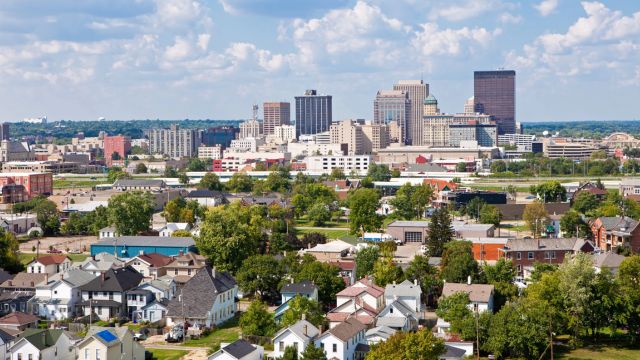
This City in Ohio Has Been Labeled the State’s Robbery Capital
Ohio, a state renowned for its historical significance and heterogeneous populace, is not without its fair share of criminal issues. Ohio had a violent crime rate of 309 per 100,000 persons in 2020, which was higher than the national average of 388, according to the most recent FBI statistics. Robbery is one of the most prevalent and hazardous forms of violent crime due to the potential use of force or the threat of force to steal another person’s property.
While robberies can occur anywhere and at any time, certain locations are more susceptible to them than others. Akron is prominently recognized as the state capital of robberies in Ohio. Population-wise, Akron ranks fifth-largest in Ohio, at approximately 197,000. It is situated in the northeastern region of Ohio, precisely 40 miles to the south of Cleveland. In addition to its scenic landscapes, industrial heritage, and cultural diversity, Akron is notorious for its high crime rate.
The Robbery Rate in Akron
The FBI estimates that there were 1,180 robberies in Akron in 2020, or 599 stolen crimes per 100,000 residents. The aforementioned rate of robberies was the greatest among all Ohio cities with a population exceeding 100,000. Furthermore, it exceeded three times the national average of 172 per 100,000 and more than doubled the state average of 246 per 100,000.
Since 2010, the larceny rate in Akron has remained consistently high, fluctuating between 500 and 700 per 100,000 individuals. When contrasting the two, the robbery rates at the state and national levels have exhibited a consistent downward trend: from 250 to 150 per 100,000 at the national level and 300 to 200 per 100,000 at the state level.
Crime-ridden Areas of Akron
A number of Akron’s neighborhoods have violent crime rates that are as much as 55% higher than the average for the city as a whole. These regions consist of:
South Akron: With 1,304 violent crimes per 100,000 individuals and a crime rate 43% higher than the city average, this is the most dangerous neighborhood in Akron. It is also the most densely populated region, with a significant minority and low-income population. Gang violence, drug trafficking, and prostitution have historically characterized South Akron, all of which contribute to the area’s high larceny rate.
Downtown Akron: comprises a multitude of establishments, including offices, stores, restaurants, and entertainment venues, and serves as the city’s central business district. It also serves as the central center for public transportation, with trains and buses linking it to other areas of the city and region. While Downtown Akron is a popular destination for commuters and tourists, it is also a haven for criminals who prey on the defenseless and vulnerable. The larceny rate in downtown Akron is 1,000 per 100,000, an amount that is 67% greater than the average rate for the city.
West Akron: Widespread and heterogeneous, West Akron comprises the westernmost region of the municipality. In addition to residential and commercial establishments, the area also contains cultural and historical landmarks. The larceny rate in West Akron is 800 per 100,000, an increase of 33% compared to the average rate for the city. Additionally, the area experiences a notable incidence of burglary and larceny, both of which are frequently associated with robbery.
Akron’s Initiatives to Prevent Crime
The Akron Police Department has been diligently employing a range of initiatives and strategies to combat the city’s robbery problem. Some such examples comprise:
Community policing: Community policing entails fostering cooperation and trust between law enforcement and the public via recurring programs, gatherings, events, and patrols. In addition to improving the safety and quality of life of the community’s inhabitants, the police work to prevent and solve offenses. Residents are also encouraged to report suspicious activities and participate in crime prevention initiatives through community policing.
Crime analysis: Collection and analysis of data pertaining to crime patterns, trends, and locations through the utilization of sophisticated software and technology constitutes crime analysis. This information is utilized by law enforcement to identify concentrations, suspects, motives, and methods of robbery in order to allocate personnel and resources accordingly. Furthermore, crime analysis aids law enforcement in assessing the efficacy of their tactics and implementing modifications when necessary.
Crime prevention education: Crime prevention education consists of instructing the general public on how to avoid becoming a robbery victim and what to do in the event that they do. One can safeguard oneself and one’s property by following the police’s recommendations and counsel, which include maintaining vigilance and awareness of one’s surroundings, avoiding isolated and dimly lit areas, securing valuables, barring doors and windows, and carrying pepper spray or a whistle. The police also urge members of the public to cooperate with the investigation and to dial 911 immediately if they experience or witness a robbery.
Conclusion
The city of Akron is replete with opportunities and attractions, but it also confronts a significant threat from robbery. Akron has one of the highest robbery rates in the nation and the highest rate in Ohio. The community and the victims may suffer physical, emotional, and financial damage as a result of a robbery, which is a violent crime. The Akron Police Department is employing a variety of strategies and measures in an effort to decrease the robbery rate. The authorities, however, cannot accomplish this alone. To improve and secure Akron as a living, working, and visiting environment, they require the participation and support of the general public, the government, and other relevant stakeholders.


